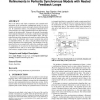305 search results - page 15 / 61 » On modeling top-down VLSI design |
GLVLSI
2005
IEEE
14 years 1 months ago
2005
IEEE
As timing requirements in today’s advanced VLSI designs become more aggressive, the need for automated tools to diagnose timing failures increases. This work presents two such a...
GLVLSI
2007
IEEE
13 years 11 months ago
2007
IEEE
he abstract and simple computation and communication mechanism in the synchronous computational model it is easy to simulate synchronous systems and to apply formal verification m...
GLVLSI
2006
IEEE
14 years 1 months ago
2006
IEEE
State-space modeling of fully differential Gm-C filters with weak nonlinearities is used to develop a fast algorithm for intermodulation distortion estimation. It results in sim...
VLSID
2004
IEEE
14 years 8 months ago
2004
IEEE
Dynamic noise analysis is greatly needed in place of traditional static noise analysis due to the ever increasingly stringent design requirement for VLSI chips based on very deep ...
GLVLSI
2000
IEEE
14 years 10 hour ago
2000
IEEE
— Typically, placement algorithms attempt to minimize the total net length of a printed circuit board (PCB). However, an MCM’s increased throughput and dense circuitry can easi...



